By Jeff Monks
The Ruger Bearcat has been the scourge of tin cans, pop bottles, and squirrels for 57 years. First introduced in 1958, the Bearcat is a trim little rimfire single-action revolver with more cowboy style than Sam Elliot’s mustache. It was immediately popular when it hit the market for under fifty bucks (the equivalent of about $400 today), and found its way into many a backpack and tacklebox. The Bearcat is styled after the Remington revolvers of the Civil War era, and named for one of Bill Ruger’s favorite cars, the Stutz Bearcat . . .
The original Bearcats were built with an aluminum alloy frame and steel cylinder. These were produced until the first revision in 1971, which replaced the alloy frame with steel and changed the name to “Super Bearcat”. In the mid-70s, Ruger began installing their new transfer-bar safety on their single-action revolver lines, making them safe to carry with a round under the hammer. At that time, it was decided that the Bearcat design wasn’t readily adaptable to the new mechanism, and the Bearcat was dropped from production in 1975.
A couple of decades later, engineers at Ruger decided that it wasn’t impossible to implement a transfer-bar system in the Bearcat after all, and 1993 saw the re-introduction of the revolver as the cleverly-named “New Bearcat” (hey, nobody ever accused the marketing folks at Ruger of being too creative). This model has been in the Ruger lineup ever since.
The subject of today’s review is the newest leaf on the Bearcat family tree, the “Shopkeeper” model. Introduced in 2013, the main differences between it and its older brothers are the bird’s-head grip and shorter barrel. Standard Bearcats have a 4.2-inch barrel, but the Shopkeeper’s is 1.2 inches shorter. The name comes from the historical preference among shopkeepers and tradesmen for smaller, cut-down revolvers like this that were easier to conceal in an apron pocket or the like. The story goes that Jason Cloessner of Lipsey’s (a major firearms distributor) was shown a customized 3″ Bearcat by one of his dealer customers, and liked it so much, he convinced Ruger to produce a shortened version for exclusive sale through his company. When he committed to buying several thousand copies, Ruger agreed, and the Shopkeeper was born.
In terms of appearance, the Shopkeeper is definitely a winner. Everything fits and functions in a very precise, tight fashion. Pulling back the hammer produces that instantly recognizable series of metallic clicks that’s Hollywood shorthand for, “Okay, now I mean business.” There’s very little wiggle room anywhere on the gun, and the joint where the frame meets the trigger guard is a very fine hairline, visible, but undetectable by touch.
Aside from the rosewood grip panels, everything on the gun is stainless steel, in an attractive brushed finish, which explains the gun’s 22-ounce weight. For a gun this small, it feels hefty, but in a comforting, solid, “this will still be a functioning firearm a hundred years from now” way, not a “this thing is a brick” way. Cylinder-to-barrel gap measures a consistent .005″ on all six chambers, and the cylinder has just a couple thousandths of fore-aft movement when the revolver is in full lock up. Speaking of the cylinder, it’s engraved with a little nature scene of a bear and a cougar (bear + cat, get it?), emphasizing the outdoor intentions of the little sixgun.
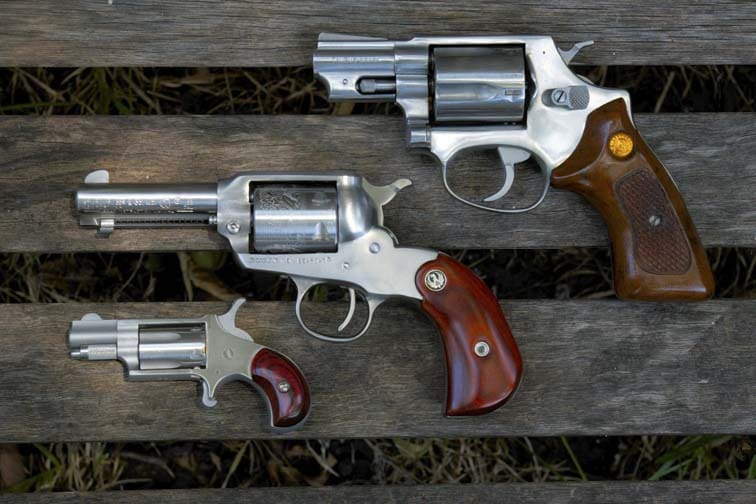
The trigger is as sweet as you’d expect a single-action revolver’s to be. There’s maybe 1/8″ of smooth takeup, then a crisp break at about four pounds. There’s another 1/8″ of overtravel, making the total trigger travel just 1/4″ or so. The trigger guard is a bit small, so folks with oversized mitts will need to leave the gloves at home. The springs are fairly light, so thumbing back the hammer is easy, helped by the gun’s excellent grip ergonomics.
At the range, that crisp trigger helps make the Shopkeeper a great performer, putting up relatively tight groups for a gun with only a 3″ barrel. At ten yards, it’s possible to get one-inch five-shot groups with quality ammo if I do everything right. At twenty-five yards, two or three inch groups were the norm. In a rest, or the hands of a shooter with better hands and eyes, I suspect the gun is capable of even a bit more accuracy than that. A lot of the variation in group size can probably be chalked up to the rudimentary, low-contrast sights. The sights are right on for windage, but shoot a bit low with most ammunition. Reliability for me has been perfect. Aside from the occasional empty case sticking a bit on ejection, hundreds of rounds of all manner of .22 ammo have all fired without a hitch. Be advised, however, that the short barrel and cylinder gap mean it’s surprisingly loud, even with lower-powered ammo.
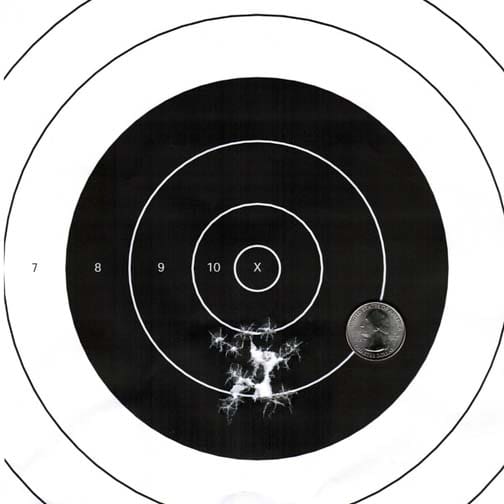
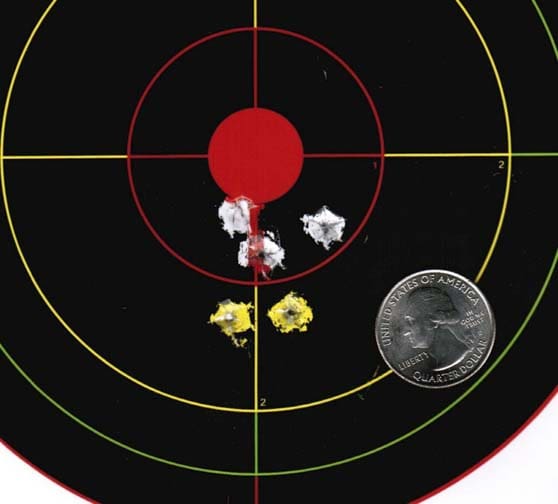
Of course, how it shoots bullseyes is sort of beside the point, because the Bearcat was never intended to be a paper punch. This little guy was born to shoot at cans, bottles, clay pigeons, tennis balls, and the like. It’s a purebred plinker, and carefully shooting it at paper targets almost seems like sacrilege, like tasking a great hunting dog with fetching your slippers. He might do it, but he’d be much happier bringing you a duck.
There’s not many guns in my safe that are more fun to bring out with a brick of .22 and a bunch of cans or clay pigeons, and not many that are less exciting to shoot at paper. Reactive targets provide a much better return on the time invested in reloading an old-fashioned gun like this.
It’s not all rainbows and butterflies, though. The diminutive size of both the gun and the cartridge it shoots means reloading is a fiddly process. To accommodate the short barrel, Ruger had to cut the ejector rod button into a crescent shape so that it would pass over the cylinder pin, allowing the ejector rod to travel a bit further for more reliable ejection of spent casings.

Even with that, you still have to give a pretty solid pop to the ejector to get the casings to fall free, and the crescent button’s sharp edges make that a bit less than comfortable after a few cylinders. Most casings will fall free when ejected, but occasionally they’ll hang up and have to be plucked out manually. Which might not be easy for you sausage-fingered fellas, because there’s not a whole lot of room for digits in the loading gate area. This generally isn’t a huge issue, because nobody is speed-reloading a single-action .22 revolver, anyway, and it has never risen to the point of annoyance such that it outweighs the fun of shooting the thing.
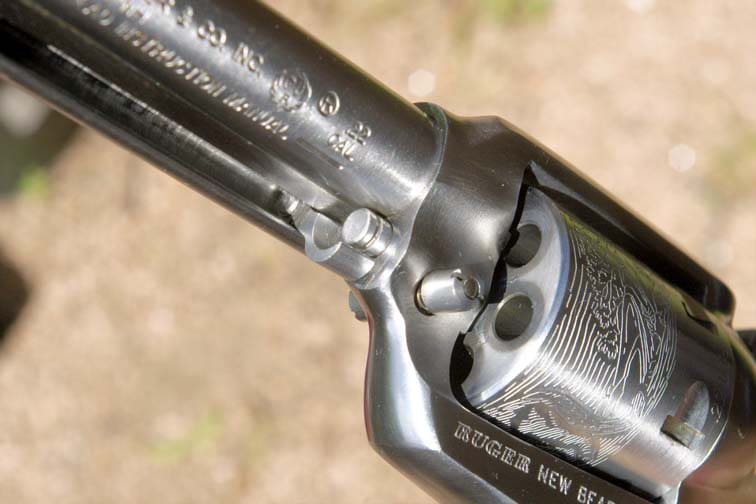
The sights are fixed, and typical of the breed. A thin, rounded blade up front and a square notch machined into the frame’s top strap are adequate for the ranges you’d likely expect to be using such a pistol, but being silver-on-silver, sight acquisition is a somewhat leisurely affair. The only fit-and-finish complaint I have on the entire gun is that the groove in the top strap is rougher, and appears to be more or less the raw casting texture. This is done, I imagine, to reduce glare off the top strap, but it’s a bit unrefined looking when compared to the finish on the rest of the gun. I’d prefer if that area had a nicer matte finish, but Ruger’s already doing a heck of a lot of machining on this gun, in an era when most handguns are made by squirting molten goo into a mold, so I’m willing to overlook it.
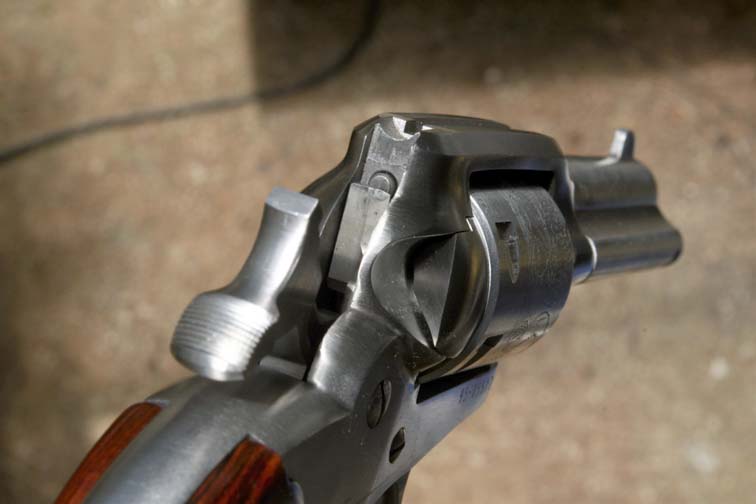
Takedown for cleaning is simple and straightforward. Pull the hammer back to the half-cock position, push in the base pin latch and pull out the cylinder pin. Open the loading gate, the cylinder drops out, and you’re free to clean the rimfire gunk out of all the nooks and crannies.
So what is this gun good for? As mentioned earlier, it makes a very handy little “kit gun” for outdoor activities. The transfer-bar mechanism means the gun can’t fire unless the trigger is pulled back, so it’s drop-safe with a round under the hammer. The Shopkeeper would be an excellent companion for a day of hiking, camping, or fishing. Inside of ten yards, I wouldn’t want to be a snake or rat on the business end of this gun. It’s also a nearly perfect gun for introducing newbies to shooting. Its cowboy good looks, unassuming size, negligible recoil, and simple manual-of-arms (not counting the tedious single-action reloading, of course) make it an excellent choice for teaching a new shooter. The inherent safety of a single-action revolver (an excited newbie who hasn’t yet mastered trigger discipline can’t pop off a second shot accidentally without consciously cocking the hammer), and the fact that you can start skittish folks off with something as tame as .22 Shorts or CB rounds makes the Bearcat a great gateway drug.
Of course, $600 is a lot to spend for a handgun just to teach new people to shoot, or for a knock-around tacklebox gun. Which is my only real gripe with the Bearcat line. It’s a little pricey for a .22LR plinker, but the quality of this gun is higher than most cheaper rimfires, and it is a real beauty. Sure, you can do most of what the Bearcat does by spending $300 on a Ruger SR22 or Walther P22, but where’s your sense of style? Sometimes you just have to treat yourself. Not to mention, there’s a heck of a lot more manufacturing labor embodied in a gun like this than in most .22LR semi-autos. And it’s an all-steel Ruger revolver. That means it’ll probably outlive you and a couple generations behind you, too.
That said, I bought this one for $400 out of the used case at the gun shop, and aside from a couple of light scratches, it looked new. It was a steal at that price, and I got very lucky that day. Would I buy one at full price? I wanted one the first time I saw one, even though the full-size Bearcat never really caught my eye. The bird’s-head shape and overall proportions of the Shopkeeper called to me, though, and it was on my wish list. But I couldn’t bring myself to pay full price for it. Now that I’ve got one and have enjoyed putting box after box of precious .22LR through it, I think it’s probably worth six bills – but only if you’re the sort of person who can appreciate the virtues of a fine mechanical device for its own sake.
Specifications: Ruger New Bearcat Shopkeeper
Caliber: .22 Long Rifle
Action: Single-action revolver
Barrel: 3 inches, 1:16 RH twist
Weight: 22 ounces
Length: 8 inches
Capacity: 6
MSRP: $693 (street price $550-$600)
Website: http://ruger.com/products/newBearcatDE/models.html
Ratings (out of five stars):
Accuracy: * * * *
The Shopkeeper shoots better than I expected for a short-barreled handgun. The crisp trigger no doubt has a lot to do with that. Fixed sights means you might have to hunt a bit to find an ammo loading that shoots directly to point-of-aim, though.
Ergonomics: * * * *
The bird’s-head grips fit the hand very naturally. The all-metal heft of the gun is reassuring and helps to stabilize it. For its small dimensions, it feels better in the hand than it should. Minus one star for the cramped trigger guard and sharp edges on the ejector rod button.
Reliability: * * * * *
100% reliable with all types of ammo tested, from Aguila Colibris to CCI Velocitors and everything in between.
Customization: *
It’s a single-action .22 revolver. Your choices for customization are pretty much limited to what color leather holster you want to get.
Overall: * * * *
An excellent little cowboy gun. If you’re a “tacticool” type of guy this isn’t the gun for you. If I had kids, this would definitely be their first handgun, and I would be confident that they could hand it down to my grandkids when the time came. It’s the kind of gun that just grabs your imagination when you pick it up, and you probably won’t put it back down until the ammo box is empty.

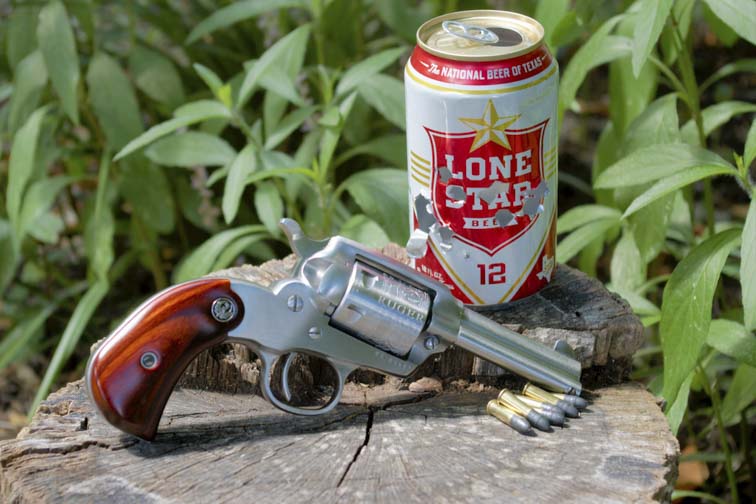
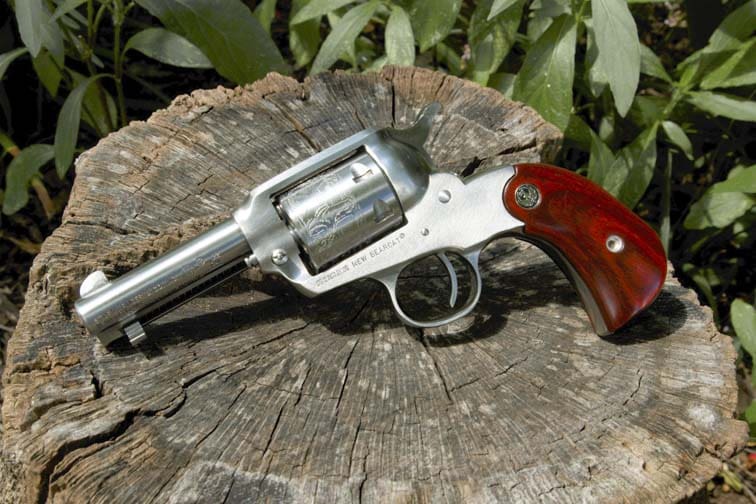

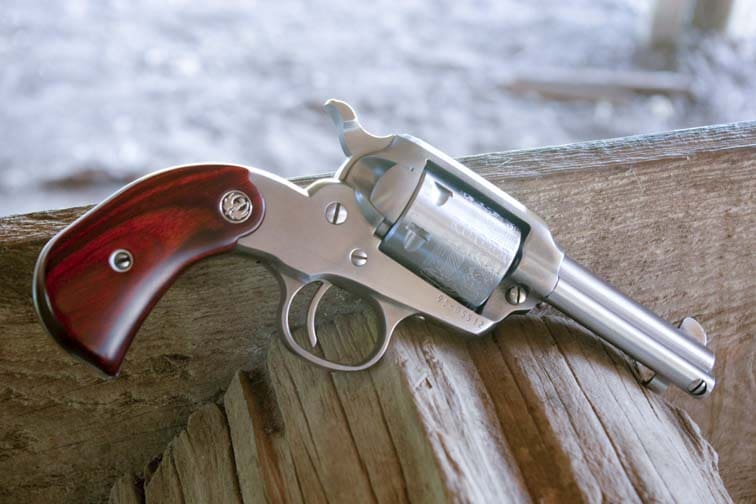
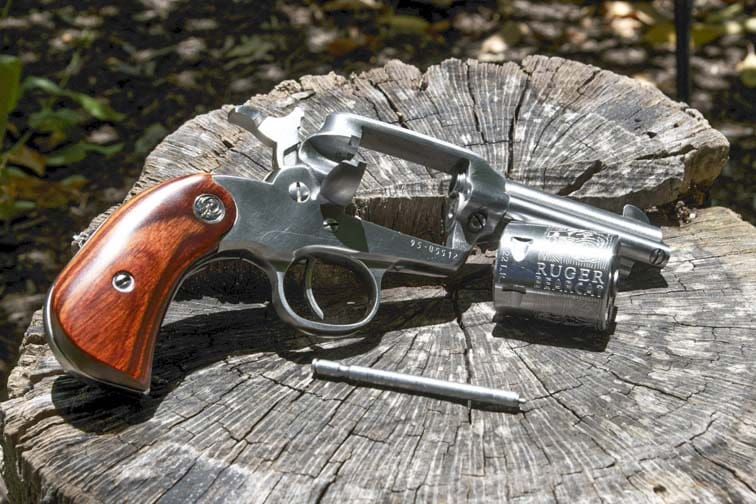



I have the single six convertible. Everybody needs a cowboy six gun.
Ruger: cram a couple more rounds into that cylinder, single-9/10 style, and I’ll buy two.
If Ruger had put better sights on it, it really would be the perfect beginner’s gun. Load it for them and all they have to worry about is line up the sights and pull the trigger.
The overall quality does seem to be very nice – however, how does this do a better job than an American Heritage SAR .22? I konw, I know an AH SAR is no where near as nice looking as the Ruger, but you can get the AH for under $200, with an added .22 WM cylinder included. I’ve had my AH SAR for 4 years now. Never had a problem. Granted, it doesn’t get a lot of abuse so I can’t say if it would hold up to banging around in a tackle box or what have you, but it seems to have held up fine – plus I can shoot just about any .22 round from it.
My Heritage RR was only $129 new last year (no mag cylinder). I also picked up a NEF R92 double action 9 shot revolver a couple years ago for $115 used. Neither is as small or classy as this gun, but they sure were cheaper. For me the $300ish I spent on my SR22 was “going upscale and fancy” for a .22 plinker. The Ruger Mark series .22 pistols also rock and are much cheaper than the Bearcat.
It is hard to pay that kind of money for a plinker. You could buy a GP100 for the same amount of dough.
I also have the Heritage. I like it just fine, even though the price was under a buck and a half! It doesn’t have the finer workmanship the the Bearcat does, but at that price, who cares.
Also the grip were really nice.
This would be the perfect starter gun foe a beginner. Safe, and cheap!
I’m of the same opinion. Ruger makes great revolvers, and the best .22 revolvers on the market, but this is a lot of money for a single action .22 six shooter. Heck, Ruger makes an EIGHT shot, double action .22 LCR for $400 and maybe less that is smaller, weighs less, etc. Charter Arms makes a 6 shot double action that’s around $350.
There’s options out there for .22 wheelguns and this is Bearcat is the most expensive. Built to the highest quality, but .22 doesn’t and never did require the highest quality to last and to function.
Sorry to hijack the thread but what I really want is a double action 22, does anyone make them anymore?
I know that Taurus & Rossi do.
Taurus
http://www.taurususa.com/product-details.cfm?id=764&category=Revolver&toggle=tr&breadcrumbseries=UL2
http://www.taurususa.com/product-details.cfm?id=899&category=Revolver&toggle=tr&breadcrumbseries=UL2
Rossi
http://www.rossiusa.com/product-details.cfm?id=228&category=1&toggle=&breadcrumbseries=
http://www.rossiusa.com/product-details.cfm?id=231&category=1&toggle=&breadcrumbseries=
Ruger SP101, S&W 617, and the Taurus 94 are all DA .22 revolvers.
LCR comes in 22 and 22 WMR as well.
Imho the sp101 in .22 kind of sucks. It’s not cowboy enough to have classic style, and not modern enough to look “cool” like the LCR. Also the factory trigger is HORRIBLE! Now the LCR .22 is fun to shoot.
The sp101 in my opinion is to over built for a .22 and the factory trigger is unbearable.
I would recommend trying to find an old Hi Standard Sentinel, mine was made in 1955 but it still runs like brand new
You can find some used double action H&R and NEF .22 revolvers. They are pretty good guns, and are relatively inexpensive.
Smith 617, more $’s, but really nice, 10 rounds too
It might be worth comparing this sweet little gun to Ruger’s other little .22 wheelgun, the SP101. Price is about the same, and it comes with fiber optic sights.
I would never buy one, but I enjoyed reading that review.
Too many tatoos. Kinda ruins the classic look.
Man, that is just too cool for words to a levergun/six-gun loving dude like myself. Dammit Ruger. Stop with the cool shit already.
At first glance, I saw “Ruger Bureaucrat” and thought to myself; “The name finally reflects the nature…”
If you amortize the $600 over the 100yr life of the gun, it’s ony $6 a year . quite a bargain.
Building a .22lr zip gun, paying the BS tax stamp, etc. Would be way funner and cheaper.
That’s a poor method of making a financial budget on what is essentially a gun meant for collections and an outdoor hobby companion.
Enjoyed the review, love the looks, sure the quality is great. Still wouldn’t buy one at that price.
While I’m a Ruger fan, I have to admit that the company’s quality control seems to be poor. Over the years I’ve owned three Ruger single-action revolvers and have had to return all of them to the factory because the actions would lock up and freeze. Two of those pieces’ problems were traced to faulty pawls. One was a Single Ten that went back to Ruger three times before the company replaced it with a Single Six. Yet I still own those revolvers and they have functioned well since the factory repairs.
To Ruger’s credit, their customer service has been excellent and fast, but those problems should have been caught before the firearms were shipped and sold. However, I’m hearing of similar complaints about other firearms manufacturers so Ruger is not alone. Still, it wasn’t all that long ago when I recall that brand new quality guns rarely had manufacturing defects. Now it’s commonplace.
Having spoken to former employees of Ruger, they’ve told me that after working there, they would NOT buy a Ruger gun for their own personal use. The most common complaint was that management (as is usually the case) doesn’t care about quality, they care about quantity. If the company wants 100 guns built in a night, they’re gonna get 100 guns built regardless of quality control and their employee’s, who have a questionable manufacturing skill set, are making $11 an hour to build these guns. It’s hard to expect people who know so little, who are making so little, to make so much.
So yeah, so long as product ships out the door, it’s no longer manufacturing’s problem, it becomes customer services’ problem.
However, these employees did praise Ruger revolvers for being high quality. Everything else… not so much.
But these problems are not just within Ruger; they’re rampant everywhere like Sig, S&W, Remington, etc. These management types come out of college dumb as a box of rocks or some other industry not related to firearm manufacturing and have no idea what they are doing, don’t know jack about manufacturing, and don’t know how to structure a training program and system to turn their employees into skilled guys who know how to build flawless guns.
The older guys are retiring and their replacements are not up to snuff and that’s Truth you can take to the bank.
And BTW, I’m a Ruger fan. I’m just calling it as I see it.
No argument with your analysis of Ruger and other gun companies, TruthTellers. My impression–and this applies to many U.S. manufacturers of any goods–is that it’s cheaper to not have a quality control department and instead let the buyers take on that role. Quite a few people will not invoke the products’ warranties and will simply sell or toss them, taking a loss. Selling crappy goods, in the long run, is bad PR for manufacturers, but maybe all they’re interested in is short-term profit.
Way back when I was a lot younger and more “into” the cowboy stuff, I desired one of those Ruger Bearcats, was even a bit jealous of a friend who got one before I did.
Then I held his.
I’m not large in body, under six foot and a buck and a half in weight, but being a carpenter and block layer, I had developed some fairly impressive hands. Much too impressive for that little pea shooter, couldn’t even get my trigger finger in the guard.
Give me a full size frame any day.
If it did .22 mag as well, I’d be shutting down my computer and going off to buy one right now!
As it is… my Bearcat ‘collection’ won’t be getting the newest generation any time soon.
Great Grandson trainer.
Nice looking gun…yeah that’s a LOT for a single action 22. But it sure is cool…(didn’t Russell Crowe have a birdshead grip in the great 3:10 to Yuma)?
I love 22’s but this is too expensive.
I love mine . If your serious about your fun time you would pay the price.
I got one and will ONLY part from it by death. It’s a beautiful and totally functional single action revolver. I wanted one when they first came out and was dissuaded by price. But, they seemed to disappear and I could not find one. I wanted one for a special birthday present but could not find one. Walked into the local gun shop and my eyes laid on it immediately. I asked to see it and told the guy to hold it while I went for the money to buy it. I have already put about 500-600 rounds through it. Shoots great. It is definitely my favorite gun.
Comments are closed.